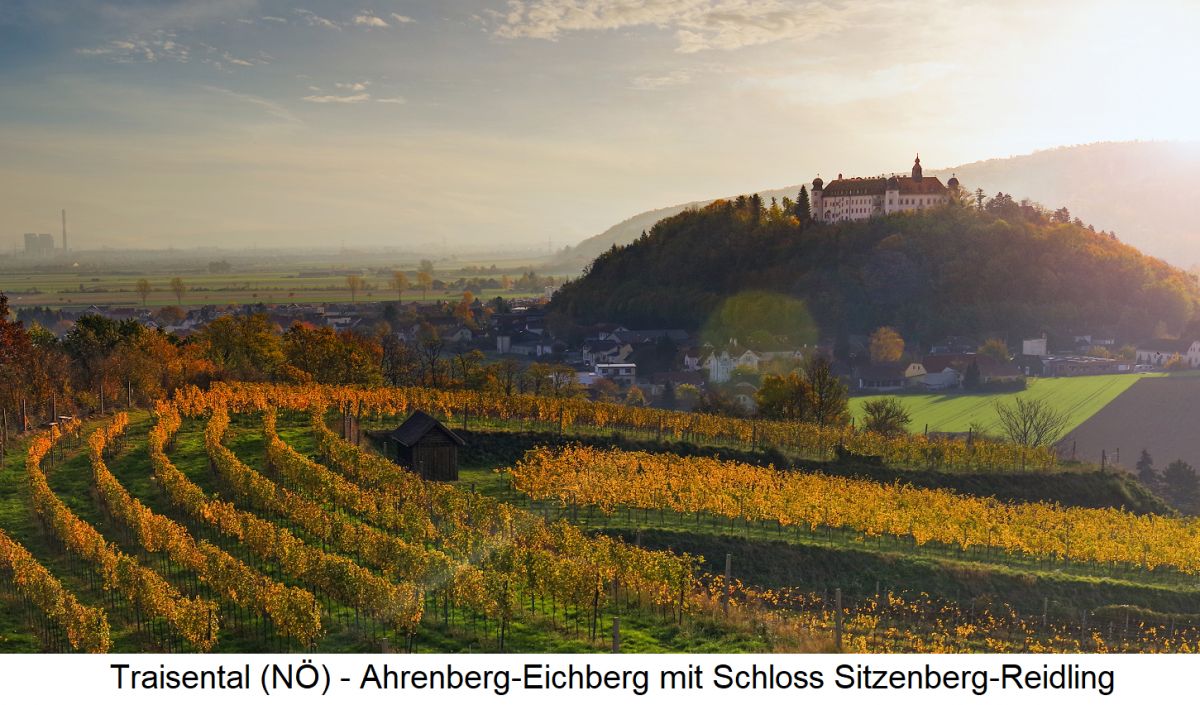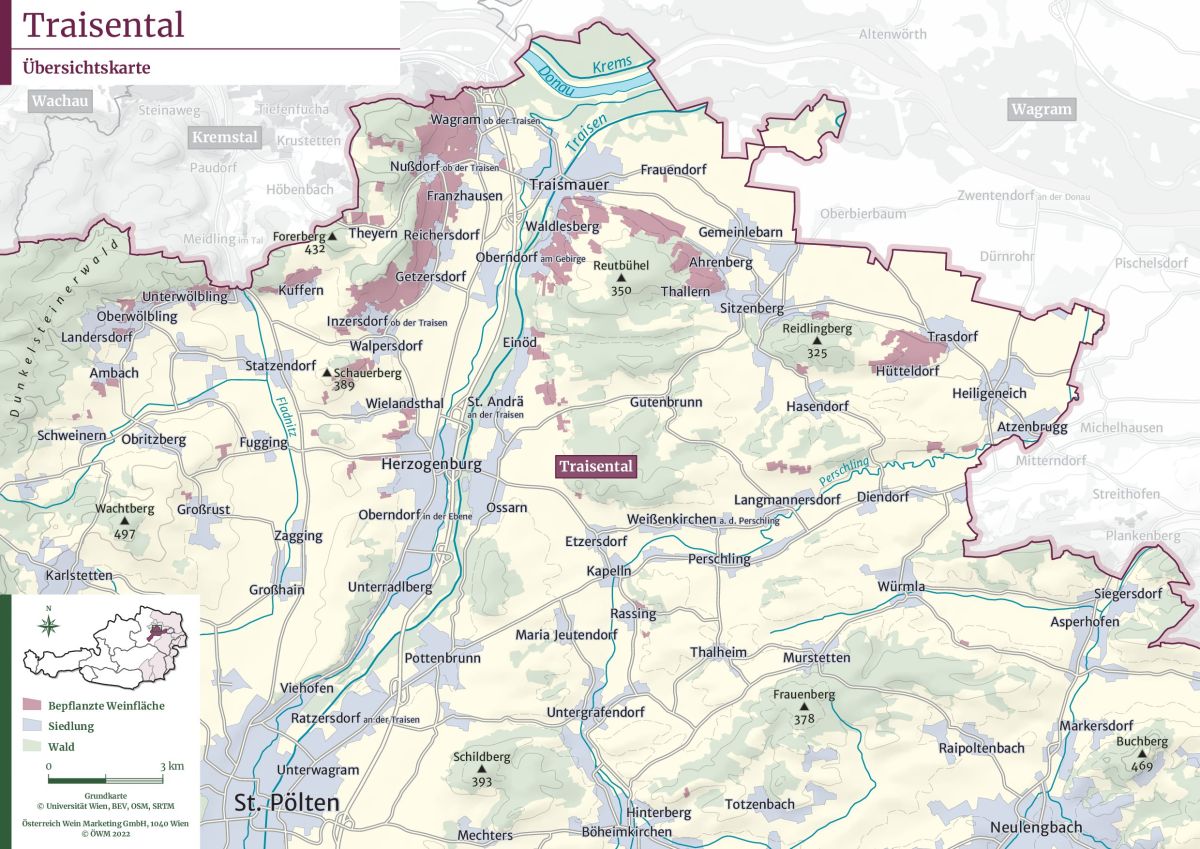Results
2,284 Results
Loading more Results ...
Loading more Results ...
| Traisental |
Description to Traisental
One of the eight specific wine-growing areas in the Austrian province or generic wine-growing region of Lower Austria. Incidentally, it is the only wine-growing region in the Mostviertel. It lies to the west of Vienna, borders the Danube to the north and is bordered to the south by the Lower Austrian capital St. Pölten. The current extent was created in 1995 by separating it from the wine-growing region of Donauland (now Wagram). The name was given by the 80 km long Traisen tributary, which flows through it from Herzogenburg in the south to Traismauer in the north and then flows into the Danube at Krems.

History
The Traisen Valley is an ancient wine-growing region. A grape seed find from the Bronze Age 2,000 B. C. and a Celtic bronze bucket from 450 B.C. with drinking scenes at a festival show it to be one of the oldest wine-growing areas in Austria. The town of Traismauer was an old Roman town; the Limes, the wall against the Germanic tribes invading from the north, ran through here. According to legend, the Nibelungs were served wine in Traismauer on their way to King Etzel. In 1673, at a wine tasting, Inzersdorf wines were rated higher than those from the Wachau.
Climate & Soils
The predominant soil type consists of dry, sandy and gravelly-loamy layers. The climate is subject to Pannonian and continental influence, the Danube has a thermoregulating effect. The largest wine-growing community is Traismauer with about 200 hectares of vineyards. In Inzersdorf, monasteries such as Passau and Salzburg already owned vineyards around 1000. Other communities are Ambach, Angern, Atzenbrugg, Getzersdorf, Herzogenburg, Inzersdorf, Nasenberg, Nussdorf, Oberndorf, Oberwölbling, Reichersdorf, Sitzenberg-Reidling, Statzendorf, Waldlesberg and Würmla. Well-known vineyards are Engelreich, Gießgraben, Grillenbühel, Hausberg (named 950), Händlgraben, Pletzengraben, Rafasetzen, Wöbling and Zwirch.

Grape variety list
In 2022, the vineyards covered a total of 849 hectares of vines. Compared to 2015 with 815 hectares, this was an increase of 34 hectares (4%). The share of red wine varieties amounts to 13%, the share of white wine varieties to 87%. Grüner Veltliner dominates with well over half of the stock, followed by Zweigelt, Riesling, Muskateller and Müller-Thurgau.
Grape variety
|
in Austria
|
Colour |
HA
|
%
|
HA
|
%
|
| Grüner Veltliner | Weißgipfler | white | 528 | 62,3 | 478 | 58,6 |
| Zweigelt | Blue Zweigelt, Rotburger | red | 69 | 8,1 | 75 | 9,2 |
| White Riesling | Riesling, Rhine Riesling | white | 53 | 6,2 | 49 | 6,0 |
| Muscat Blanc | Yellow M., Red M. / Muscat Blanc | white | 29 | 3,4 | 20 | 2,4 |
| Müller-Thurgau | Rivaner | white | 20 | 2,3 | 27 | 3,3 |
| Chardonnay | Morillon - not used in Lower Austria | white | 19 | 2,2 | 16 | 1,9 |
| Sauvignon Blanc | Muscat Sylvaner | white | 15 | 1,7 | 13 | 1,5 |
| Blue Portugieser | - | red | 15 | 1,7 | 29 | 3,5 |
| White Burgundy | Pinot Blanc, Klevner | white | 13 | 1,5 | 13 | 1,5 |
| Frühroter Veltliner | Malvasia | white | 11 | 1,3 | 12 | 1,4 |
| Blauburger | - | red | 7 | 0,8 | 10 | 1,2 |
| Neuburger | - | white | 5 | 0,6 | 9 | 1,1 |
| St. Laurent | - | red | 4,4 | 0,5 | 4,7 | 0,6 |
| Merlot | - | red | 4 | 0,5 | 3,6 | 0,4 |
| Roter Veltliner | - | white | 3,6 | 0,4 | 3,8 | 0,5 |
| Pinot Noir, Pinot Noir | Pinot Noir, Blue Pinot Noir | red | 3,5 | 0,4 | 3,9 | 0,5 |
| Cabernet Sauvignon | - | red | 3,3 | 0,4 | 3,2 | 0,4 |
| Bouvier | - | white | 2,7 | 0,3 | 3,2 | 0,4 |
| Muscat Ottonel | - | white | 2,6 | 0,3 | 2,4 | 0,3 |
| Blaufränkisch | - | red | 0,6 | 0,1 | 2,9 | 0,3 |
| Muscat Ottonel | - | white | 2,6 | 0,3 | 2,4 | 0,3 |
| Traminer | Gewürztraminer, Red T., Yellow T. | white | 2,4 | 0,3 | 2,4 | 0,3 |
| Welschriesling | - | white | 2,2 | 0,3 | 2,3 | 0,3 |
| Roesler | - | red | 2,1 | 0,2 | 1,8 | 0,2 |
| Flower muscatel | - | white | 1,6 | 0,2 | - | - |
| Muscaris | - | white | 1,2 | 0,1 | - | - |
| Grey Burgundy | Pinot Gris, Ruländer | white | 1,1 | 0,1 | 1,0 | 0,1 |
| Syrah | Shiraz | red | 1,1 | 0,1 | 0,9 | 0,1 |
| Sylvaner | Green Sylvaner | white | 0,9 | 0,1 | 1,6 | 0,2 |
| Blaufränkisch | - | red | 0,6 | 0,1 | 2,9 | 0,3 |
| Rotgipfler | - | white | 0,6 | 0,1 | 0,2 | - |
| Scheurebe | seedling 88 | white | 0,3 | - | 0,3 | - |
| Goldburger | - | white | 0,2 | - | 0,6 | 0,1 |
| Rathay | - | red | 0,2 | - | 0,6 | 0,1 |
| Rotgipfler | - | white | 0,6 | 0,1 | 0,2 | - |
| Souvignier gris | - | white | 0,4 | - | - | - |
| Zierfandler | Late red | white | 0,1 | - | 0,2 | - |
| Cabernet Franc | - | red | 0,1 | - | 0,1 | - |
| Furmint | - | white | 0,1 | - | - | - |
| Gold muscatel | - | white | 0,1 | - | - | - |
| Jubilee Vine | - | white | 0,1 | - | - | - |
| Blue Wildbacher | - | red | 0,1 | - | - | - |
| Rose muscatel | - | red | 0,1 | - | - | - |
| remaining varieties | - | white/red | 26 | 3,1 | 20 | 2,5 |
WHITE SORT |
|
white |
735 |
87 |
672 |
82 |
RED SORT |
|
red |
114 |
13 |
143 |
18 |
TOTAL |
|
|
849 |
|
815 |
|
DAC system
Starting with the 2007 vintage, the origin-controlled quality level Traisental DAC was introduced. All other quality wines must be marketed with the origin Lower Austria, the Land wines under the winegrowing region designation Weinland. In addition to the generally valid DAC conditions, special rules apply.
The quality wine grape varieties Grüner Veltliner and Riesling are permitted. The wines must be vinified dry. Starting with the 2016 vintage, a three-tier system was introduced to emphasise the origin more strongly. There are lower limits for the alcohol content, but no upper limits compared to before. The date for the application to obtain the State Assay Number is staggered. If the decision is positive (usually within one week), the wine may be marketed:
- Traisental DAC, to. 11.5% vol; 1 January
- Traisenstal DAC with indication of place; at. 12% vol; 1 January
- Traisental DAC with indication of place and vineyard (indication of "Ried" and vineyard name); at. 12.5% vol; 1 January
- Traisental DAC Reserve; at. 13% vol; 1 July
The wines must show a characteristic typicity in taste. For Grüner Veltliner: fruity, fine spiciness, no botrytis note, no perceptible wood note (toast aroma), balanced, not alcoholic. For Riesling: fragrant, aromatic, elegant, mineral, no botrytis dominance, no wood note, balanced, not alcohol-heavy. For Reserve: strong style, distinct regional and varietal aromas, dense and long finish, a delicate botrytis and woody tone is permissible.
Producers
Well-known wineries are Brindlmayer Karl, Dockner Thomas, Hauleitner Herwald, Herzinger Reinhard, Hofmann Rudolf, Holzer Andreas, Huber Markus, Kreimel Herbert, Neumayer Ludwig, Nolz Josef, Ott Thomas, Pernikl Walter, Preiß Friedrich, Schöller Hans and Steyrer Bernhard. Many businesses are members of the Traisentaler Weingärtner association. Another large winegrowers' association is Traditionsweingüter Österreich. A selection of the best wines of the Wedin growing region are available for commented wine tasting and sale at the Schlossvinothek Traismauer.
Pictures: © ÖWM - Marcus Wiesner
Classified wine producers in Traisental 3
find+buy for Traisental 5
Recent wines 68
 Weingut Brachmann
— Lower Austria/Niederösterreich
2018 Traisental Grüner Veltliner trocken Alte Reben
8.70 €
Weingut Brachmann
— Lower Austria/Niederösterreich
2018 Traisental Grüner Veltliner trocken Alte Reben
8.70 €

 Winzerhof Erber
— Lower Austria/Niederösterreich
2016 Traisental Ried Antingen Grüner Veltliner trocken "S"
12.50 €
Winzerhof Erber
— Lower Austria/Niederösterreich
2016 Traisental Ried Antingen Grüner Veltliner trocken "S"
12.50 €

 Weingut Tom Dockner
— Lower Austria/Niederösterreich
2017 Traisental Ried Pletzengraben lieblich
Weingut Tom Dockner
— Lower Austria/Niederösterreich
2017 Traisental Ried Pletzengraben lieblich

The most important grape varieties
More information in the magazine
- Between Riesling, Baroque and Grüner Veltliner Wine-growing regions in Austria: Traisental
- The two unstoppables Blaufränkisch from Austria and Germany in comparison
- "We winegrowers need legal certainty in uncertain times" Interview: Alois Höllerer, "Happy Situation" initiative
- Our wine tips for the barbecue: From the Wachau to the Priorat Currently tasted
- The paradoxical year Riesling 2022
- "I try to think a hundred years ahead" Interview: Willi Bründlmayer
- Discover Chardonnay in an entirely new way Unusual pairing tips from René Kollegger
- Paradisiacal times! Tasting: European sparkling wines for the festive season
- The land of Blaufränkisch Wine-growing regions in Austria: Mittelburgenland
- Delightful border region Wine-growing regions in Austria: Rosalia